Energy
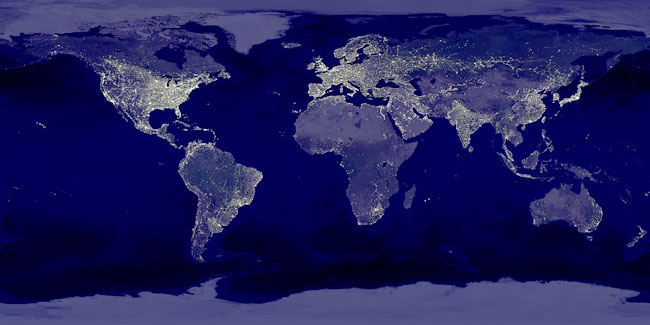
Earth at Night - From Astronomy Picture of the Day

Earth at Night - From Astronomy Picture of the Day
Alternatives include:
Wood
Alcohol
Biomass Energy
Municipal Solid Waste
Geothermal Energy
Geothermal Heat Pumps
Wind Energy
Solar Thermal and Photovoltaic
Nuclear Fusion
Oil Shale, and Tar Sands
Conservation and efficiency
If you look at the pie chart below it should be very clear to you that most of the energy we use comes from three main fossil fuels: oil (petroleum), natural gas, and coal. In this unit we will try to show you how nature creates these fuels, what they are used for and what (if anything) could replace them.
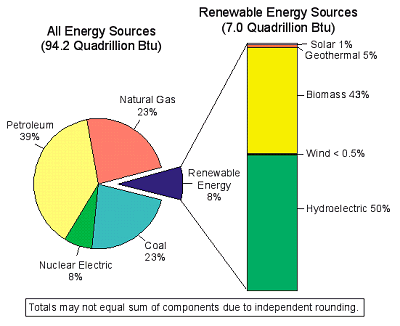
US Energy Consumption, 1998 Source EIA
(Note: Petroleum = Oil)
As the organic material is converted to oil, it tends to migrate towards the surface because oil has a rather low density (lower than water). Oil or gas needs a porous and permeable rock formation, such as sandstone or limestone to percolate into and accumulate. Oil also needs an impermeable rock layer to trap and stop the natural migration to the surface. There are several ways to "trap" the oil and natural gas inside the earth. Contrary to common belief, these deposits of oil do not exist in pools but are saturated in rocks much the same way groundwater is saturated in loose sediments.
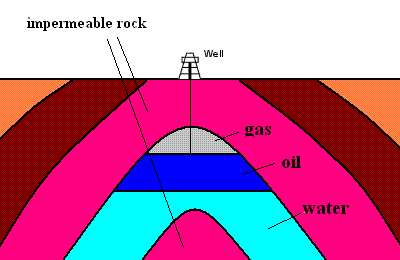
Anticline trap The natural gas and oil are capped by a folded impermeable rock layer.
|
Fault trap Gas and oil can be trapped when faults produce the correct geometry. |
|
Stratigraphic trap An angular unconformity can sandwich oil and gas as shown above.
|
Salt Dome trap Because salt deposits have a lower density, they tend to migrate towards the surface much like the blobs seen rising in a "lava lamp". When they do, they can deform a horizontal capping layer which then traps the oil and natural gas. This is common in the gulf of Mexico.
|
Petroleum is used for : medicines, fertilizers, foodstuffs, pesticides,
plastics, synthetic rubber, building materials, lubricants, paints, soaps,
clothing, etc...but mostly for a fuel (oil) to run our planes, trains,
and automobiles and (natural gas) to heat our buildings and water. One
barrel (42 gallons) yields 21 gallons of gasoline, 3 gallons of jet
fuel, 9 gallons of gas oil and distillates, 4 gallons of lubricants, and
3 gallons of heavier residues.
Only 30% of the oil in a well is easy to recover. Primary recovery of oil relies on natural pressure to squeeze out the oil from the porous rock. To get the rest, enhanced recovery methods must be used. Water or gas injection (secondary recovery) is used to increase the reservoir pressure. Steam injection (tertiary recovery) is typically used to reduce the viscosity of the remaining oil and this further increases the amount of oil that can be pumped out of the reservoir. Some engineers even inject detergents to dissolve the oil to a liquid with a lower viscosity ... then reverse the process once it is removed from the ground. These methods are not used routinely because they are expensive. When the price of oil increases, there is greater incentive to use them. Domestic oil exploration is not cheap. A single well costs 1 million dollars to drill. Most wells come up empty!
Who has all the oil? World wide, only 300 oil sites (known as giants) contain three quarters of the world's discovered oil. Almost all nations have some oil production , but primary concentrations are in the Persian Gulf, North and West Africa, the North Sea, and the Gulf of Mexico. Of the 90 oil producing nations, 5 are in the Middle East contain two thirds of the world's known oil reserves.
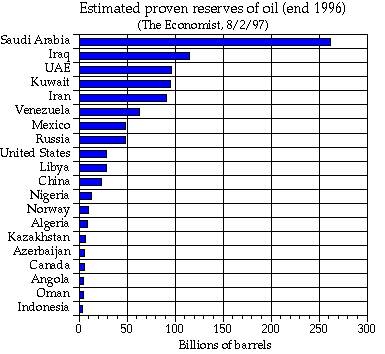
Permission from Penn State
How much oil do we use?
One barrel of oil (42 gallons) = 840 miles for an average car.
The US consumes about 15 million barrels per day.
The general trend is: Each year we use more oil, each year we import a higher percent of our oil! IN 1994, U.S. OIL IMPORTS EXCEEDED 50% OF CONSUMPTION FOR THE FIRST TIME. In 2006, US imports were about 10 million barrels per day, compared to our domestic production of about 5 million barrels per day. You do the math.

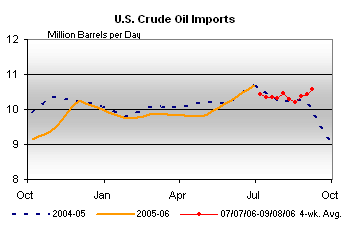
Credit DOE
The price we pay!

Credit DOE
1973 Arab Oil Embargo
1981 Downturn begins (Iran/Iraq war)
1986 Price Crash
1990 Gulf War
2002-2003 worker strike in Venezuela
Click here to see the current price of oil.
The chart shows that the price of oil fluctuates wildly. Much of the price is set by the oil producing nations (like OPEC). Unlike most items, the cost of crude oil is not related to its production cost. It is an artificial price based on demand. For this reason, domestic investment in oil exploration and investments in alternatives to oil become economically unrealistic. If the U.S. decides to invest huge resources in alternatives to oil (oil shale or tar sands), all OPEC has to do is lower its price and the project fails!!!!
Here is a on line
lecture
on oil
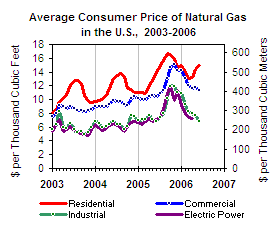
Credit DOE

Credit DOE
It is mainly used in the home to heat buildings and produce hot water. Industry uses a lot of natural gas in the production of steel, glass, paper and many other industries (wherever heat is needed in the production process). For the most part, we are relatively self sufficient in the production of Natural Gas although we do import from Canada. View the statistics here.
Coals are classified into three main types: lignite, bituminous coal (soft coal .. plentiful but dirty), and anthracite (hard coal ... cleaner burning but less abundant) . These classifications are based on the amount of carbon, oxygen, and hydrogen present in the coal.
The US has an ample supply of coal. In fact, the US is a major exporter of coal. It is estimated that the United States has about 35 percent of the world's potentially minable coal reserves, the largest of any nation. The Federal Energy Information Administration reports that the United States has close to 500 billion tons of demonstrated reserves (minable with current technology). According to the U.S. Geological Survey, the United States may have as much as four trillion tons of coal resources. Known coal reserves are expected to last for centuries at current rates of usage.
In the southeast, coal is mined underground and in strip mines in West Virginia, Kentucky, and Tennessee. Coal is also mined underground and in strip mines in the Midwest, in Illinois, Ohio, and Indiana. In the west, coal is mined in large open-pit mines and strip mines primarily in Wyoming, Utah, North Dakota, Montana and Arizona.
Source USGS
Coal is primarily used to generate electricity and manufacture steel. Heat from the burning coal is used to generate steam which spins one or more turbines ... which generates electricity.
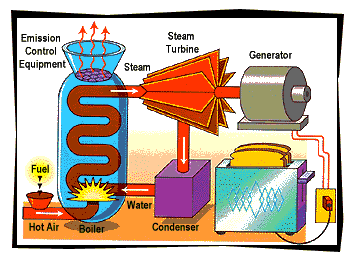
seeking permission from Southern
Co.
Wisconsin Electric - coal 67%; nuclear 24%; hydro 2%; natural gas/oil
1%; purchased 6%
For the entire US, coal is used to produce 56% of the electricity we
use (1998) ... nuclear energy supplies about 19% and almost all of the
rest comes from burning oil or gas. Hydroelectric power is used in
isolated areas such as the state of Washington.
Nitrogen oxides and fine airborne particles produce asthma, reduce lung function, and cause respiratory diseases and premature death for many thousands of Americans. Smog forms when nitrogen oxides and reactive organic gases combine, especially on warm, still days. Sulfur dioxide and nitrogen oxides both combine with water in the atmosphere to create acid rain ... killing off plants, fish, and the animals.
Global warming is caused by many gases, but carbon dioxide is responsible for at least half of the warming. About 80% of global carbon dioxide emissions come from power plants.
Coal facts - click
here
Nuclear energy is used to generate electricity. 24% of the
electricity We Energies supplies comes from nuclear sources (19%
nationally).
U235 can give a continuous supply of energy because if it is hit by a neutron, its nucleus splits into two smaller nuclei producing heat and an additional supply of neutrons. These additional neutrons can then go on and initiate other reactions. This process is called fission. This can mean that one neutron can create a million more in a short period of time, and also produce vast quantities of heat energy.

Credit NRC
The uranium is formed into ceramic pellets and are inserted into long, vertical tubes within the reactor. The nuclear reaction is controlled by rods inserted among the tubes holding the fuel. These control rods are made of a material that absorbs neutrons and prevents them from hitting atoms which can fission. So the nuclear reaction can be speeded up or slowed down by varying the number of control rods withdrawn and how much they are withdrawn. Steam is used to make electricity just as it is at a power plant burning fossil fuel - by spinning the turbine that drives an electric generator.
In the US, presently, there are 109 operating power plants. Since 1981, the financial burdens imposed by these requirements have made it so difficult to build and operate new nuclear power plants that utility companies in the states of Washington, Ohio, New Hampshire, and Indiana have been forced to abandon partly completed plants after spending billions of dollars on them.
I don't think availability of fuel is an issue (at least in the US). There may not be any nuclear power plants in the US to use the fuel we already have. Cost isn't an issue either. Energy from the existing nuclear power plants is cheaper than electricity from coal fired power plants.
The main issues about nuclear energy are safety (and waste disposal).

Is there a threat of terrorism (extremist viewpoint) with nuclear wastes (or have I just watched too many James Bond movies)?
How do you dispose of nuclear wastes safely? - I'm not sure you can!
When an uranium atom is split to start the fission reaction, there are radioactive atoms produced. Most by-products of the fission reaction have short half-lives. Almost all radioactivity disappears after four months so they do not impose a major problem. However, some radioactive atoms make up the high level waste. These wastes can remain radioactive for long periods of time.
The possibilities for disposal of high level waste include burial far beneath the surface of the earth. The waste could be imbedded in rock or salt formations. Some researchers prefer salt formations because most of these formations have not changed over millions of years. Some researchers prefer the granite (rock) over the salt. Testing is continuing on this issue, with other options, like ocean burial, being discussed. Until we have a national policy, these wastes are "warehoused" in temporary storage sites.
Here is a good question - Which you rather live one mile away from -
a standard coal fired power plant or a nuclear power plant?
Hydropower is a clean, domestic and renewable source of energy. Hydropower plants provide inexpensive electricity and produce no pollution. However, the best sites for hydroelectric plants are near swift flowing rivers or steams, mountainous regions and areas with heavy rainfall. This is great for the state of Washington but very bad for Wisconsin.
What is the alternative for oil? You need a cheap liquid fuel which can be used in cars. We already moved to "gasohol" which is a 10% blend of alcohol and gasoline. Gasoline can be extracted from tar sands, oil shale and even coal but at great costs. The cost of oil needs to be much higher to make these alternatives feasible. That won't happen soon since the oil producing nations can simply lower oil prices to bankrupt these industries. I believe that E85 is a good start. This is a blend of 85% ethanol (which newer cars can run on). It means we grow our own fuel. Of course the problem then becomes ... are we taking food off the table to do this? You have heard the phrase "there is no free lunch" .. well, in this case there may not be any lunch at all. I love the concept of hybrid cars .. so much that I've left it open for you to research in the discussion board.
What is the hope for solar energy? - Back in the 1980's, the country put much hope in developing solar energy (I even taught a course in it). However, solar energy's biggest impact would be in domestic space heating (which is currently based on natural gas). We have a good supply of this clean fuel. But even in Wisconsin it has been shown that with better house design (passive solar and active owners), homes can save about half of their present amounts of fuel for space heating. Development in solar energy would NOT relieve our dependence on foreign oil. The best way we can turn sunlight into a fuel for cars is through hydrolysis of water. That is, use solar energy to split a water molecule into two gasses .. hydrogen and oxygen (the stuff that makes up water). Once you have hydrogen gas, you can use it in a fuel cell to make electricity (for electric cars) or burn it like natural gas. Here is the problem: First you need a commitment on a national scale to produce vast quantities of hydrogen (back to the old problem ... OPEC just lowers prices and that idea dies). Ok, so even if we get past that point, we need to develop a cost effective fuel cell that can compete with current prices of electricity ... we are not even close yet to that goal. Using sunlight to run our cars is many decades away ... sorry. I hope to live long enough to see a hydrogen pump at every gas station .. so far I haven't seen one.
Alternatives to coal and nuclear energy would require a way to make electricity on demand using a different fuel. Wind blows, but only some of the time ... photo cells make electricity but only when the sun shines (and not cheap either). There is too little geothermal and biomass to make an impact. So as long as we want our toasters to toast and our mixers to mix ... we need coal and nuclear (both offering risks to the public).
The key is conservation! Use less and we need less. Car pool, live closer to work, consolidate trips and get a smaller car. This not only saves you money but relieves our addiction to foreign oil.
Starting in the fall of 2007, MATC will be offering a course called - NatSci
162 (Energy in Nature, Technology and Society). Look for it .. it should
be interesting.
ŠJim Mihal 200, 2006 - all rights reserved